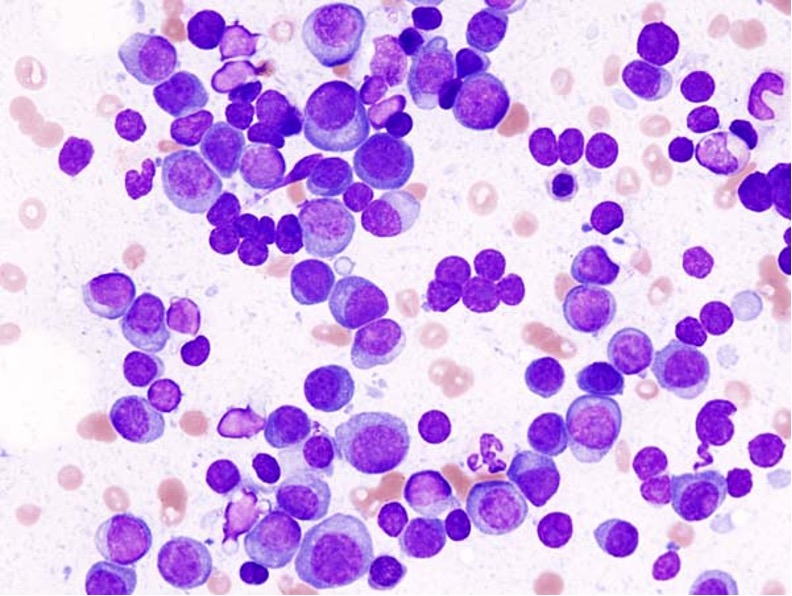
Figure 1: Smear preparation of bone marrow from a patient with multiple myeloma, the cancer of plasma cells
Source: Wikimedia Commons
Activated B lymphocytes, or plasma cells, are the only cells capable of secreting antibodies and thus play a critical role in mediating immune response to pathogens (D’Souza & Bhattacharya, 2019). The production of an abnormal monoclonal protein by these cells characterizes Monoclonal Gammopathy of Undetermined Significance (MGUS), which is typically an asymptomatic disorder (Kaseb et al., 2020). However, a mutation in the antibody can cause progression of MGUS to multiple myeloma, where long lived plasma cells in the bone marrow proliferate uncontrollably, becoming cancerous and interfering with the incidence and function of healthy white blood cells (Bird & Boyd, 2019).
An important target in therapies against multiple myeloma and other cancers is the T lymphocyte, a type of adaptive immune cell which plays an important role in antitumor immunity (Kumar et al., 2018). Required for T cell activation is recognition of a specific antigen, a molecule that can be bound by key players in the immune response like antibodies. T cells interact with antigen-presenting cells, which express peptide fragments of antigens on cell-surface complexes called MHC molecules (Janeway et al., 2001). Activated T cells fall into two general lineages: T helper cells and cytotoxic T cells, and they regulate the activities of other cells in the immune response or directly kill antigen host cells, respectively (Pennock et al., 2013). Interesting findings show that CD8+CD28-CD57+ T cells, which are regulatory T cells (T regs), have immunosuppressive effects on killer-T cells when isolated from multiple myeloma patients but not when isolated from healthy donors (Filaci et al., 2007). Further study revealed immunosuppressive activity of these T cells is induced by cytokine (an immune signaling molecule) IL-10, known for its ability to obstruct pathogen clearance by suppressing immune response (Plaumann et al., 2018).
Awwad et al. found that signaling lymphocyte activation molecule family 7 (SLAMF7) was highly expressed on this subset of immunosuppressive T cells in multiple myeloma patients. Prior research has shown that SLAMF7 is expressed on other immune cells and multiple myeloma cells and exhibits immunosuppressive activity (Guo et al., 2014). Thus, Awwad et al. set out to establish the role of SLAMF7 in Tregs in the context of multiple myeloma. Notably, they first found that SLAMF7+ T regs were also more likely to express protein PD-1 (Awwad et al., 2021). Expression of PD-1 is a major regulator in leading T cells toward their “exhausted” state where they no longer execute their immune response against an antigen of interest (Lee et al., 2015). These data suggest the immunosuppressive mechanism could involve inducing the exhausted state in T cells that should be clearing antigen.
The researchers separately cultured SLAMF7+ and SLAMF7- T regs in the presence of target multiple myeloma antigen and antigen-presenting cells. The killer T cells that were grown under the presence of CD8+CD28-CD57+ SLAMF7+ T regs possessed much weaker cytotoxic activity, as expected. It was also found that IL-6 and IL-8, two cytokines with differing functions in the immune response were upregulated in SLAMF7+ culture. This suggests that IL-6 and IL-8 could be key players in suppressing the immune response of cytotoxic T cells by T regs(Awwad et al., 2021).
The scientists then sought to verify the results by using elotuzumab, an anti-SLAMF7 antibody, in the treatment of multiple myeloma patients compared to a control group. They found that there was significant loss of SLAMF7+ T cells in patients receiving elotuzumab. Frequency of SLAMF7 expression on CD8+CD28-CD57+ T cells dropped from 49% to less than 8% following treatment. Further investigation revealed the mechanism for killing was antibody-mediated phagocytosis of SLAMF7+ T cells by macrophages (Awwad et al., 2021). These phagocytic cells were able to recognize antigen on the surface of SLAMF7+ CD8+ T cells and ingest these immunosuppressive cells as a result (Rosales & Uribe-Querol, 2017).
Results of this study show that anti-SLAMF7 antibody elotuzumab is capable of binding to regulatory CD8+ T cells expressing SLAMF7 and inducing their killing through phagocytosis by macrophages. Considering the immunosuppressive effects of this subset of T cells, treatment involving such mechanisms could prove helpful in multiple myeloma and potentially other cancers.
References
Awwad, M., Mahmoud, A., Bruns, H., Echchannaoui, H., Kriegsmann, K., Lutz, R., Hundemer, M. (2021). Selective elimination of immunosuppressive t cells in patients with multiple myeloma. Retrieved February 25, 2021, from https://www.nature.com/articles/s41375-021-01172-x
Bird, S., & Boyd, K. (2019). Multiple myeloma: An overview of management. Retrieved February 25, 2021, from https://www.ncbi.nlm.nih.gov/pmc/articles/PMC7065505/
D’Souza, L., & Bhattacharya, D. (2019). Plasma cells: You are what you eat. Retrieved February 25, 2021, from https://pubmed.ncbi.nlm.nih.gov/30874356/
Filaci, G., Fenoglio, D., Fravega, M., Ansaldo, G., Borgonovo, G., Traverso, P., (2007). CD8+ CD28- T regulatory lymphocytes inhibiting T cell proliferative and cytotoxic functions infiltrate human cancers.
Guo, H., Cruz-Munoz, M. E., Wu, N., Robbins, M., & Veillette, A. (2014). Immune cell inhibition By SLAMF7 is mediated by a mechanism Requiring Src KINASES, CD45, And Ship-1 that is defective in multiple myeloma cells. Retrieved February 25, 2021, from https://pubmed.ncbi.nlm.nih.gov/25312647/
Janeway, C., Travers, P., & Walport, M. (2001). Antigen recognition by t cells. Retrieved February 25, 2021, from https://www.ncbi.nlm.nih.gov/books/NBK27098/
Kaseb, H., Annamaraju, P., & Babiker, H. M. (2020). Monoclonal gammopathy of undetermined significance. Retrieved February 25, 2021, from https://www.ncbi.nlm.nih.gov/books/NBK507880/
Kumar, B., Connors, T., & Farber, D. (2018). Human t cell development, localization, and function throughout life. Retrieved February 25, 2021, from http://www.ncbi.nlm.nih.gov/pmc/articles/PMC5826622/
Lee, J., Ahn, E., Kissick, H., & Ahmed, R. (2015). Reinvigorating exhausted t cells by blockade of the pd-1 pathway. Retrieved February 25, 2021, from https://www.ncbi.nlm.nih.gov/pmc/articles/PMC5341794/
Pennock, N., White, J., Cross, E., Cheney, E., Tamburini, B., & Kedl, R. (2013). T cell responses: Naive to memory and everything in between. Retrieved February 25, 2021, from https://www.ncbi.nlm.nih.gov/pmc/articles/PMC4089090/
Plaumann, J., Engelhardt, M., Awwad, MHS., Echchannaoui, H., Amman, E., Raab, MS., (2018). IL-10 inducible CD8+ regulatory T-cells are enriched in patients with multiple myeloma and impact the generation of antigen-specific T-cells.
Rosales, C., & Uribe-Querol, E. (2017). Phagocytosis: A fundamental process in immunity. Retrieved February 25, 2021, from https://www.ncbi.nlm.nih.gov/pmc/articles/PMC5485277/
Related Posts
Modeling Maximum Running Speed in Animals
Figure: Two cheetahs lie side by side. As the fastest...
Read MoreIncarceration and Motherhood: A Brief Overview of Maternal Health Issues in American Prisons
Figure 1: Guards in prisons are able to put prisoners...
Read MoreArtificial Intelligence for Mental Health Services
Source: Pavel Danilyuk In recent years, due to the pandemic...
Read MoreMatthew Lutchko



